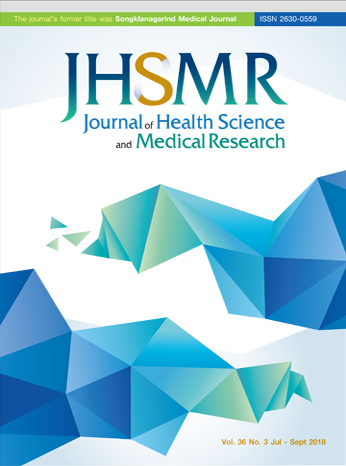Comparison of Tumor Target Volume on Four-Dimensional Computed Tomography and 18F-FDG PET/CT in Lung Cancer
DOI:
https://doi.org/10.31584/jhsmr.2018.36.3.18Keywords:
4DCT, lung cancer, PET/CT, taget volumeAbstract
Objective: The correlation between 18F-fluorodexyglucose (18F-FDG) positron emission tomography/computed tomography (PET/CT) and four-dimensional computed tomography (4DCT) based-tumor volumes is unclear. This prospective study was conducted to determine the optimal threshold of PET/CT for gross tumor volume (GTV) delineation using 4DCT as the standard reference for locally advanced lung cancer patients.
Material and Methods: Ten patients with histologically proven primary lung cancer who underwent radiotherapy from June 2017 to March 2018 in Ramathibodi Hospital were enrolled in the study. The 4DCT simulation and 18F-FDG PET/CT simulation were performed on the same position and same date. Eight standard uptake value (SUV) thresholds of SUV 1.5.0-2.0 and 15.0-35.0% of maximum SUV were selected for contouring in order to be compared with 4DCT based tumor volumes. The comparison methods used were the mean percentage volume change, dice similarity coefficient (DSC), and 3D-centroid shift of the targets between 18F-FDG PET/CT-based gross tumor volume (GTVPET) and internal gross tumor volume (IGTV) from 4DCT.
Results: The largest and smallest volume of primary tumors were 422.6 cm3 and 5.9 cm3. GTVPET contoured using SUV 1.5 (GTVPET1.5) approximated closely to IGTV in all the parameters, including volume change, DSC, and 3D-centroid shift. The best median percentage volume change, median DSC, and median centroid shift between IGTV and GTVPET1.5 were 5.55, 0.745 and 0.37, respectively.
Conclusion: GTVPET contoured by 18F-FDG PET at SUV1.5 corresponded most closely to the IGTV in all parameters. Further study with a larger sample size and clinical outcome analysis is needed.
References
2.Novello S, le Chevalier T. Is there a standard strategy in the management of locally advanced non-small cell lung cancer? Lung Cancer 2001;34:9-14.
3.Sause W, Kolesar P, Taylor SI, Johnson D, Livingston R, Komaki R, et al. Final results of phase III trial in regionally advanced unresectable non-small cell lung cancer: Radiation Therapy Oncology Group, Eastern Cooperative Oncology Group, and Southwest Oncology Group. Chest 2000;117:358-64.
4.Curran WJ, Paulus R, Langer CJ, Komaki R, Lee JS, Hauser S, et al. Sequential vs concurrent chemoradiation for stage III non–small cell lung cancer: randomized phase III trial RTOG 9410. J Natl Cancer Inst 2011;103:1452-60.
5.Chang JY, Dong L, Liu H, Starkschall G, Balter P, Mohan R, et al. Image-guided radiation therapy for non-small cell lung cancer. J Thorac Oncol 2008;3:177-86.
6.Underberg RW, Lagerwaard FJ, Cuijpers JP, Slotman BJ, van Sornsen de Koste JR, Senan S. Four-dimensional CT scans for treatment planning in stereotactic radiotherapy for stage I lung cancer. Int J Radiat Oncol Biol Phys 2004;60:1283-90.
7.Guckenberger M, Wilbert J, Meyer J, Baier K, Richter A, Flentje M. Is a single respiratory correlated 4DCT study sufficient for evaluation of breathing motion? Int J Radiat Oncol Biol Phys 2007;67:1352-9.
8.Zhang X, Zhao KL, Guerrero TM, McGuire SE, Yaremko B, Komaki R, et al. 4D CT-based treatment planning for intensity-modulated radiation therapy and proton therapy for distal esophagus cancer. Int J Radiat Oncol Biol Phys 2008;72:278-87.
9.Rietzel E, Pan T, Chen GT. Four-dimensional computed tomography: image formation and clinical protocol. Med Phys 2005;32:874-89.
10.Johnston E, Diehn M, Murphy JD, Loo BW Jr, Maxim PG. Reducing 4D CT artifacts using optimized sorting based on anatomic similarity. Med Phys 2011;38:2424-9.
11.Sazon DA, Santiago SM, Soo Hoo GW, Khonsary A, Brown C, Mandelkern M, et al. Fluorodeoxyglucose-positron emission tomography in the detection and staging of lung cancer. Am J Respir Crit Care Med 1996;153:417-21.
12.Patz EF Jr, Lowe VJ, Hoffman JM, Paine SS, Burrowes P, Coleman RE, et al. Focal pulmonary abnormalities: evaluation with F-18 fluorodeoxyglucose PET scanning. Radiology 1993;188:487-90.
13.Ashamalla H, Rafla S, Parikh K, Mokhtar B, Goswami G, Kambam S, et al. The contribution of integrated PET/CT to the evolving definition of treatment volumes in radiation treatment planning in lung cancer. Int J Radiat Oncol Biol Phys 2005;63:1016-23.
14.Fox JL, Rengan R, O’Meara W, Yorke E, Erdi Y, Nehmeh S, et al. Does registration of PET and planning CT images decrease interobserver and intraobserver variation in delineating tumor volumes for non-small-cell lung cancer? Int J Radiat Oncol Biol Phys 2005;62:70-5.
15.Biehl KJ, Kong FM, Dehdashti F, Jin JY, Mutic S, El Naqa I, et al. 18F-FDG PET definition of gross tumor volume for radiotherapy of non-small cell lung cancer: is a single standardized uptake value threshold approach appropriate? J Nucl Med 2006;47:1808-12.
16.Gondi V, Bradley K, Mehta M, Howard A, Khuntia D, Ritter M, et al. Impact of hybrid fluorodeoxyglucose positron-emission tomography/computed tomography on radiotherapy planning in esophageal and non-small-cell lung cancer. Int J Radiat Oncol Biol Phys 2007;6:187-95.
17.Faria SL, Menard S, Devic S, Sirois C, Souhami L, Lisbona R, et al. Impact of FDG PET/CT on radiotherapy volume delineation in non-small-cell lung cancer and correlation of imaging stage with pathologic findings. Int J Radiat Oncol Biol Phys 2008;70:1035-8.
18.Hong R, Halama J, Bova D, Sethi A, Emami B. Correlation of PET standard uptake value and CT window-level thresholds for target delineation in CT-based radiation treatment planning. Int J Radiat Oncol Biol Phys 2007;67:720-6.
19.Duhaylongsod FG, Lowe VJ, Patz EF Jr, Vaughn AL, Coleman RE, Wolfe WG. Detection of primary and recurrent lung cancer by means of F-18 fluorodeoxyglucose positron emission tomography (FDG PET). J Thorac Cardiovasc Surg 1995;110:130-40.
20.Hanna GG, van Sornsen de Koste JR, Dahele MR, Carson KJ, Haasbeek CJA, Migchielsen R, et al. Defining target volumes for stereotactic ablative radiotherapy of early-stage lung tumours: a comparison of three dimensional 18F-fluorodeoxyglucose positron emission tomography and fourdimensional computed tomography. Clin Oncol 2012;24:e71-80.
21.Duan YL, Li JB, Zhang YJ, Wang W, Li FX, Sun XR, et al. Comparison of primary target volumes delineated on four-dimensional CT and 18 F-FDG PET/CT of non-smallcell lung cancer. Radiat Oncol 2014;9:182.
























